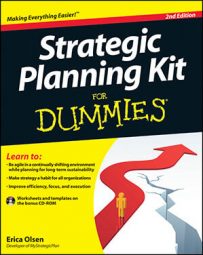Expense and revenue estimating is an imperfect science; during strategic planning it’s meant to give you an idea of the additional cash outlay you need to implement each area of your plan and the revenue you can expect to generate.
You may already have identified potential expenses for action items as well as potential revenue for each target market group you develop. Here you combine that information with your current operations to get a complete financial picture. Identifying large expenses that may prohibit implementation is important.
Strategic plan revenue estimate
An easy approach for estimating potential revenue is to estimate the potential revenue for each target customer group separately. Ideally, your market research gives you a rough idea of how much revenue or sales per customer you can anticipate generating. Before you can determine estimated revenue, you need to find out the following information:
Estimated number of customers: _____
Estimated average sale per customer: _____
Estimated number of sales per customer per year: _____
Plug this data into the following formula to determine the estimated revenue in a year:
Strategic plan expenses estimate
List expenses associated with any goal or action in the plan that aren’t part of your normal operating expenses. Additionally, estimate your current operating expenses by forecasting each item based on how it increases to accommodate for the expected growth.
Strategic plan financial assumptions
As you’re thinking about your revenue and expenses, undoubtedly you’re making some assumptions, such as the sale price of your products, the cost of materials, your lease payment, and so on. Instead of keeping these estimates in your head, write them down. These assumptions are called financial assumptions. You gain the most insight from projecting your financial future when the assumptions that drive the projections are comprehensive and written out.
A list of assumptions is simply a list of givens that you’re basing your projections on. Your list should include all revenue and expense assumptions related to running your organization. You use these assumptions in the steps you follow in the “Projecting your financial future” section later in this chapter.
Here are some tips to keep in mind when you develop your assumptions:
Don’t overthink this part of your financial analysis. The goal of developing projections isn’t about perfectly predicting the future. Most people have rather foggy crystal balls. Following this exercise can help make your crystal ball a little clearer.
Have a few knowledgeable individuals (your mentors) review your assumptions. Choose people who will be painfully honest with you. Are you being too conservative or not conservative enough? Are you missing anything that you need to include in your projections?
Consider developing best-case and worst-case scenarios, such as +10 percent growth and –10 percent growth. Identify which of your assumptions may vary widely and use those to develop a scenario. Common scenarios are based on growth rate, number of customers, and product or service price.
Whenever possible, estimate the odds of your scenarios. No need to break out the statistics book — just answer for yourself which of your scenarios is most likely and why.

